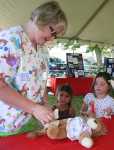Hundreds flock to annual Children's Health Fair event

Colin Henry brought in the clinic's third patient of the day. The six-year-old was very attached to his buddy, Bear, who needed urgent attention. Alicia Maldonado looked over the patient and quickly identified the problem.
Bear needed several stitches to get back to full health -- in a manner of speaking. The youngster watched as the clinic staff completed their treatment. After a few minutes, the child toted his stuffed animal beneath his arm as they went to check out the rest of the day's activities, possibly looking for an adventure to share.
The same scenario played itself out several times Saturday afternoon as hundreds of people gathered around Elmore Medical Center for this year's children's health fair. During the annual event, local residents had a chance to see first-hand the different emergency equipment and tools used by paramedics, fire fighters, doctors and nurses.
In addition, an assortment of community organizations opened booths to highlight healthy living programs as well as outlets to promote the well being of children in Mountain Home and surrounding communities.
But it was the free teddy bear clinic that remained the focus of several medical staff members from the county hospital. The clinic was an initiative introduced by a nurse at the local hospital, who saw it used successfully at another hospital, said Doreen Krabbenhoff, a spokesperson with the medical center.
Lou Ann Watson, a registered nurse at the medical center here also used the clinic to show children like Emma Frampton how doctors and nurses here apply bandages and gauze to treat various injuries.
During her nine years at the local medical center, nearly a quarter of emergency room patients Watson deals with are children. When rolled into the hospital, children typically have the same reaction. They don't like going to the emergency room when they get bumps and bruises because they associate doctors and nurses with needles from vaccinations they received when they were younger, Watson said.
Going to the ER tends to scare children in other ways as well, she added.
"We're all strangers to these children, and they're in pain," she added. "They either cry or get real quiet and don't want to tell you what hurts. Only a few of them are willing to talk to you."
Those that talk tend to have one message for doctors and nurses: "I don't want any needles."
Efforts like the teddy bear clinic helps puts things in a not-so-scary perspective for children, Watson said.
Other outlets available during the health fair helped medical staff members and emergency workers break down other fears children have when they go to the hospital. In addition to sampling frozen treats and other food, children could sit in the pilot's seat of an air ambulance flown from St. Luke's Regional Medical Center or hop in an ambulance or rescue truck. Some youngsters enjoyed playing games or testing their skills as aspiring doctors.
But for children like Colin, it was a chance for them to "heal" their injured friends and take them home for more days of fun and adventure.
